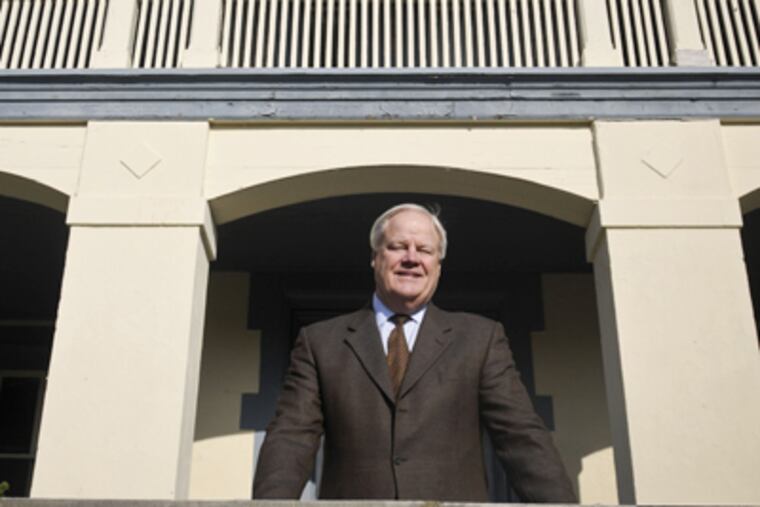Revival of Wayne mansion not to everyone's liking
Just after the end of the Civil War, the first hint of a coming Gilded Age arrived in Wayne in the form of an 80-room stone mansion with a grand porch and a manicured lawn - a plush home for a wealthy banker named J.H. Askin, who named it for his daughters, Louisa and Ella.

Just after the end of the Civil War, the first hint of a coming Gilded Age arrived in Wayne in the form of an 80-room stone mansion with a grand porch and a manicured lawn - a plush home for a wealthy banker named J.H. Askin, who named it for his daughters, Louisa and Ella.
In the 145 years that followed, Louella Mansion - overlooking the Wayne business district - went through a wave of reincarnations, as a hotel, then a girls' school, and finally a 25-unit apartment complex suffering from advancing age.
Once the centerpiece of Askin's successful scheme to build a suburban community around a Pennsylvania Railroad station 14 miles west of Philadelphia, the 1866 landmark now has a developer who would like to return it to its roots.
Louella Mansion again would be a home for affluent suburban families - not one, but 12 in overhauled condominiums, with 21st-century twists such as a two-car garage for each owner.
Developer Cas Holloway says the demand for small, prestigious condominium projects in towns like Wayne has never been stronger.
"The market for this product has been steady throughout the worst of times," Holloway said.
Two similar projects that he built nearby, 102 Louella and Steepleview, have been popular with well-heeled empty nesters. Wayne's "walkability" is a big draw, he said.
In the center of town, the once-spectacular building is now a creaky apartment house in need of serious updating. Holloway plans to gut the building and carve out two- and three-bedroom condominiums of up to 2,200 square feet with 11-foot ceilings, fireplaces, and patios.
But residents of the historic district surrounding the mansion - 17 houses built in the 1920s in a semicircle - are not happy to see their quaint neighborhood turned into a magnet for millionaires. They say a 24-spot underground garage, topped with an elevated green roof and Victorian garden, will block their views. Earlier, they had lobbied against an aboveground garage.
They also say that the restoration will remove treasured architectural details such as the mansion's original floor-to-ceiling windows and dormer roof.
"We know it has to be developed," Susan Byrne said. "It's this development we don't want."
With the Radnor Township Planning Commission recommending the project, it seems likely the Board of Commissioners will give it the green light. A public meeting is scheduled for Jan. 9 and a final vote in February.
Both sides agree that the mansion is a historic treasure - though not historically certified.
Askin owned 293 acres that today are a bustling downtown with restaurants, boutiques, a movie theater, and other amenities appealing to the new upper class. After Askin downsized to a smaller home, Louella and the surrounding property was bought in 1880 by banker A.J. Drexel and newspaper editor G.W. Childs to form a larger development they called Wayne Estate.
The mansion was expanded and converted to a hotel in the 1880s and later served as the Armitage School for Girls before becoming apartments in the 1920s.
Though it is still a stately building with north and south entrances, marble steps, etched glass transoms, crown molding, and high ceilings, it also has spotty heat, exposed wires, tiny, out-of-date kitchens, and no sprinklers.
How much of the original architecture will be retained has been debated since Holloway first proposed the project last year. The building is in one of three historic districts and was favorably reviewed by the township's Historic and Architectural Review Board.
Holloway says he will retain the center hall and grand staircase and some of the brick walls, but just about everything else must be replaced.
"It's very easy for someone to romanticize the building and what's here," he said. "We're going to breathe a whole new life into it, a whole new use." The units will run from $795,000 to $1,175,000.
Owner Clement Chang of Acer Capital said he couldn't keep up with the rapidly deteriorating building. Much of the structure does not comply with building codes.
"Some apartments are too hot, some too cold. This is an old system," he said.
Holloway said he would duplicate the unique windows with energy-efficient models, as well as the roof, dormers, and wood panels on the huge doors.
"It's possible to renovate and restore and give the building new life and bring it up to today's standards," he said.
But Helen Gallagher, who lives across from the mansion, sees the end of a way of life for the cozy neighborhood.
"It's going to wreck the whole neighborhood, the whole ambience," she said. "We won't be able to see the houses across the street."
And while the tenants of the apartment come from all walks of life, she said, "now it will be millionaires."